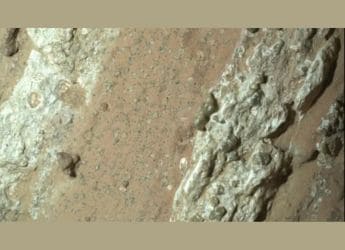- Home
- Science
- Science News
- 'Potato' or 'Raggedy' Mars Moon? NASA Releases Image of Phobos
'Potato' or 'Raggedy' Mars Moon? NASA Releases Image of Phobos
NASA shared the image of Phobos on its official Instagram handle.

Photo Credit: Instagram/ NASA
Mars has two moons — Phobos (pictured) and Deimos
NASA has released an intriguing image that appears like a potato, but it is not. The image, captured by the most powerful camera ever sent to another planet, is of Phobos, the largest of Mars' two raggedy moons. The other moon of the Red Planet is called Deimos. In an Instagram post, the space agency said the image was taken by the HiRISE camera aboard its Mars Reconnaissance Orbiter spacecraft, about 6,800 km above the surface. NASA said Phobos is nearing Mars at a rate of 1.8 metres every century, meaning it will either crash into the planet in 50 million years or break up into a ring of debris.
Phobos has no atmosphere and it orbits Mars three times a day. One popular theory is that it might be a captured asteroid, NASA said, but some scientists dispute this. NASA added in the post that Phobos was discovered in 1877 by American astronomer Asaph Hall. In Greek mythology, Phobos and Deimos are the twin sons of Ares (Mars in Roman mythology), said NASA.
In the caption, NASA mentioned “the image shows a pockmarked celestial body with a large impact basin called Stickney crater. The grooves seen along its side could be the result of tidal forces – the mutual gravitational pull of the planet and the moon."
Take a look at the image here:
Many Instagram users were amazed after seeing the image.
A user, Ziggy Manzoni, said “It looks like it's made of some kind of metal.”
“It's so amazing! I've never seen it before,” said Jobbe Pilgaard.
American astronomer Asaph Hall discovered both the moons of Mars in 1877. Hall named the moons for the mythological sons of Ares, the Greek counterpart of the Roman god, Mars. Phobos, which means fear, is the brother of Deimos. The crater was named after his wife and mathematician Chloe Angeline Stickney Hall.
According to NASA, the measurement of day and night temperatures on Phobos has shown extreme variations. It had a high temperature of -4 degrees Celsius and a low of -112 degrees Celsius.
Scientists believe this intense heat loss is likely a result of the dust on Phobos' surface, which is unable to retain heat.
Get your daily dose of tech news, reviews, and insights, in under 80 characters on Gadgets 360 Turbo. Connect with fellow tech lovers on our Forum. Follow us on X, Facebook, WhatsApp, Threads and Google News for instant updates. Catch all the action on our YouTube channel.
Related Stories
- Samsung Galaxy Unpacked 2025
- ChatGPT
- Redmi Note 14 Pro+
- iPhone 16
- Apple Vision Pro
- Oneplus 12
- OnePlus Nord CE 3 Lite 5G
- iPhone 13
- Xiaomi 14 Pro
- Oppo Find N3
- Tecno Spark Go (2023)
- Realme V30
- Best Phones Under 25000
- Samsung Galaxy S24 Series
- Cryptocurrency
- iQoo 12
- Samsung Galaxy S24 Ultra
- Giottus
- Samsung Galaxy Z Flip 5
- Apple 'Scary Fast'
- Housefull 5
- GoPro Hero 12 Black Review
- Invincible Season 2
- JioGlass
- HD Ready TV
- Laptop Under 50000
- Smartwatch Under 10000
- Latest Mobile Phones
- Compare Phones
- Honor Win RT
- Honor Win
- Xiaomi 17 Ultra Leica Edition
- Xiaomi 17 Ultra
- Huawei Nova 15
- Huawei Nova 15 Pro
- Huawei Nova 15 Ultra
- OnePlus 15R
- Asus ProArt P16
- MacBook Pro 14-inch (M5, 2025)
- OPPO Pad Air 5
- Huawei MatePad 11.5 (2026)
- Xiaomi Watch 5
- Huawei Watch 10th Anniversary Edition
- Acerpure Nitro Z Series 100-inch QLED TV
- Samsung 43 Inch LED Ultra HD (4K) Smart TV (UA43UE81AFULXL)
- Asus ROG Ally
- Nintendo Switch Lite
- Haier 1.6 Ton 5 Star Inverter Split AC (HSU19G-MZAID5BN-INV)
- Haier 1.6 Ton 5 Star Inverter Split AC (HSU19G-MZAIM5BN-INV)

















